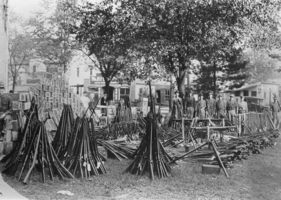 | Back to e-WV
| Back to e-WV
 The West Virginia Encyclopedia
The West Virginia Encyclopedia
 | Back to e-WV
| Back to e-WV
 The West Virginia Encyclopedia
The West Virginia Encyclopedia

The Paint Creek-Cabin Creek Strike of 1912–13 was one of the most dramatic and bloody conflicts in the early 20th-century labor struggles in southern West Virginia known as the Mine Wars. The strike began on April 18, 1912, when the coal operators on Paint Creek near Charleston rejected the demand of their unionized workers for a wage increase. As the strike spread to nearby Cabin Creek and other nonunion mining sections, the dispute focused increasingly on the larger issue of unionization. While economics remained important, more of the strikers’ demands focused on recognition of the United Mine Workers of America as their bargaining agent and sought an end to the use of mine guards, black listing, and the denial of workers’ rights to free speech and assembly.
Claiming that the UMWA was a tool of their competitors in the Midwest, the coal operators were determined to break the strike and drive the union out. The mine district quickly became an armed camp as the operators brought in hundreds of Baldwin-Felts detectives, built machine gun emplacements, evicted strikers, and began importing nonunion workers. The miners secured weapons of their own. Inspired by labor activists such as the fiery Mother Jones and aided by the Socialist Party, they took the offensive. Guerrilla warfare and pitched battles at places such as Mucklow, Dry Branch, and Eskdale inflicted significant casualties to both sides by early 1913.
The strike’s continuing bloodshed and the attempts by two West Virginia governors to curtail it brought national attention. In an unprecedented exercise of military rule during peace time, Governor Glasscock imposed martial law on the district three times. More than 200 miners and their allies, including the 86-year-old Jones, were arrested. And, in what the union maintained was a flagrant abuse of their rights to be tried in civil courts, a hundred or more of these civilians were court-martialed and sentenced to prison terms. Many thought that Glasscock’s successor, Henry D. Hatfield, acted in a heavy-handed manner when he imposed a settlement on the strike. Although Governor Hatfield pardoned the majority of the court-martialed defendants, he kept the most radical strike supporters in jail without charges and sent the National Guard to close the Socialist newspapers in Charleston and Huntington. Hatfield’s actions helped ensure an inquiry into the strike in 1913 by the U.S. Senate, the first investigation into the actions of a state government by a committee of Congress.
The Paint Creek-Cabin Creek Strike was also notable for producing a group of new leaders in District 17 who would influence labor relations in southern West Virginia for several decades. Fueled by continuing discontent with the Hatfield settlement, Cabin Creek miners led a revolt which resulted in the election in 1916 of rank and file activists, including Frank Keeney as president and Fred Mooney as secretary-treasurer. Keeney and Mooney led District 17 miners in the dramatic struggle of the early 1920s, culminating in the massive armed march on Logan and the Battle of Blair Mountain.
e-WV presents West Virginia Public Broadcasting on the Paint Creek-Cabin Creek Strike
Written by Fred A. Barkey